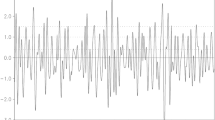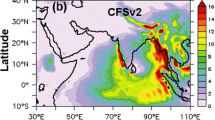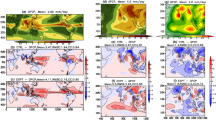Abstract
Stratiform rain and associated cloud processes play an important role in the Indian summer monsoon rainfall propagation and distribution. In spite of improvement in model resolution, the parameterization of stratiform cloud processes remains elusive. An attempt is made here to improve the parameterization of stratiform processes of NCEP (National Center for Environmental Prediction) CFSv2 (climate forecast system version 2.0) coupled model for better simulation of the Indian summer monsoon. Physically more realistic cloud microphysics scheme (WSM6) suitably modified with Indian aircraft observation along with a revised simplified Arakawa Schubert (RSAS) and modified radiation parameterization has been implemented in CFSv2. The simulation of stratiform rainfall and its northward propagation by a modified version of CFSv2 (CFSCR) is compared with the default CFSv2. The improved cloud parameterization enables the model to realistically simulate the stratiform rain and its fraction against the convective rain of the model. The CFSCR is also able to improve the stratiform rain efficiency in the model. This development demonstrates that improved cloud processes can resolve the issue of erroneous convective and stratiform fraction in CFSv2.
Access provided by Autonomous University of Puebla. Download chapter PDF
Similar content being viewed by others
Keywords
1 Introduction
Capturing the Indian summer monsoon mean state and its spatiotemporal variability is a challenge (Waliser et al. 2003; Lin et al. 2008; Sperber and Annamalai 2008). While there is significant progress in the past few decades in understanding and improving the monsoon prediction, there are still certain areas of challenges which the numerical modelers are thriving to achieve. As described by earlier works, the intraseasonal oscillations are the building blocks of mean monsoon and are responsible for the spatiotemporal variabilities over the Indian subcontinent (Goswami and Ajayamohan 2001). One of the limitations of numerical models is to capture the cloud and convection realistically (Webster et al. 1998; Dai 2006; Yoo et al. 2013). A number of studies (Jiang et al. 2011; Rajeevan et al. 2013; Abhik et al. 2014) emphasized the role of multiscale clouds and convection on different phases of monsoon. Further study by Chattopadhyay et al. (2009) emphasized the role of stratiform rain on the northward propagation of intraseasonal oscillations. These studies indicate the pivotal role of stratiform precipitation and associated cloud processes on the seasonal mean as well as intraseasonal oscillation. Further studies based on observational data by Abhik et al. (2014) and Jiang et al. (2011) threw a new insight on the cloud and its role on the stratiform process and monsoon ISOs. Keeping in tune with the multiscale nature of monsoon convection, many recent developments, e.g., super-parameterized CFS by Goswami et al. (2015), the stochastic multi-cloud model in CFSv2 (Goswami et al. 2017), showed much promise in improving the representation of cloud and convection during Indian monsoon vis-à-vis the mean and intra-seasonal oscillations. However, in both these approaches, the improvement of stratiform rain was not addressed specifically. Study by Houze (1997) mentioned that large-scale anvil is the potential source of stratiform rain. Taking the observation-based studies into account and the variety of cloud types, a recent development of Climate Forecast System version 2 (CFSv2) model is reported by Abhik et al. (2017). In this development, the microphysical processes of CFSv2 model are represented with a cloud model having processes required to provide stratiform rainfall. However, the paper did not elaborate much about the stratiform rain and associated process. In this article, a detailed analysis is carried out to document the improvement of stratiform rainfall with a modified version of CFSv2 in comparison to default CFSv2 and also with respect to observation.
2 Data and Methodology
The NCEP CFSv2 (Saha et al. 2014) is a fully coupled ocean–land–atmosphere dynamical modeling system. It uses NCEP Global Forecast System (GFS) atmospheric GCM (Moorthi et al. 2001) and Geophysical Fluid Dynamics Laboratory (GFDL) Modular Ocean Model version 4p0d (Griffies et al. 2004) as an oceanic component. The atmospheric component has a spectral resolution of T126 (~100 km) with 64 sigma-pressure hybrid vertical layers and the oceanic component has a zonal resolution of 0.25°–0.5° with 40 vertical layers. More details about the CFSv2 model and its various physical schemes are documented in Saha et al. (2014). The default CFSv2 has simplified the Arakawa–Schubert (SAS) mass flux-based convective parameterization scheme (Pan and Wu 1995). The revised version of CFSv2 includes RSAS convective parameterization scheme (Han and Pan 2011). The detailed differences between SAS and RSAS are well documented in Han and Pan (2011). The model also uses a simple cloud microphysics scheme with ice physics developed by Zhao and Carr (1997) based on Sundqvist et al. (1989). In addition to RSAS scheme, a six-class WSM6 microphysics scheme (Hong and Lim 2006) is incorporated in place of two-class Zhao and Carr (1997) microphysics scheme in CFSv2. Prognostic water substance variables in WSM6 contain water vapor, cloud water, cloud ice, rainwater, snow, and graupel. More detailed description about WSM6 can be found in Hong and Lim (2006). In order to keep consistency with the modified convective and cloud microphysical processes, the cloud hydrometeors generated by WSM6 are included during the computation of cloud fraction in the RRTM radiation scheme. Further details about the model setup are documented in Abhik et al. (2017) and modified suitably using System of Atmospheric Model (SAM) (Khairoutdinov and Randall 2003) shown in Fig. 1. We have carried out two separate free runs of 15 years of CFSv2 with default SAS and default microphysics scheme (CTRL hereafter) and with RSAS and WSM6 scheme (CFSCR) with the same initial condition. In the present study, we have analyzed the past 12 years of simulation to avoid influences of model spin-up.
To validate the model simulation, the Tropical Rainfall Measuring Mission (TRMM) 3B42 version 7 (V7) (Huffman et al. 2007) daily data at a horizontal resolution of 0.25° × 0.25° for the year 1999–2010 are used. TRMM 3G68 (Kummerow et al. 2001) derived daily convective and large-scale rainfall is analyzed.
3 Results and Discussions
Based on the model simulation, daily climatological rainfall is plotted from observation and also from the control run of CFSv2 (CTRL) and the modified version of CFSv2, i.e., CFSCR. The annual cycle of rainfall is shown in Fig. 2. The smoothed rainfall annual cycle is plotted for two boxes namely 72°E–83°E, 15°N–25°N covering mostly the central Indian monsoon zone and another is over 70°E–90°E and 10°N–25°N covering part of the Bay of Bengal. The annual cycle over both these boxes shows an improvement by CFSCR. Improvements in the length of the monsoon season, onset, and dry bias by the CTRL have been particularly improved.
To depict the gradual northward propagation of the rainfall belt during boreal summer, longitude averaged (70E–90E) rainfall is plotted with latitude versus month. Figure 3a shows the northward propagation of the rainfall belt in TRMM data. It is evident from Fig. 3b that CTRL produces a much wet bias over equatorial Indian ocean during Boreal summer (June–July–August–September) and also over the south of the equator during Boreal winter. It may be noted from Fig. 3b that northward propagation is relatively week in CTRL and mostly rainfall belt remain confined over the oceanic region causing wet bias (Goswami et al. 2014). CFSCR (Fig. 3c) overcomes the problem of too much rain over the oceanic region and also improves the wet bias during boreal winter.
To get further insight about the propagation of daily rainfall belt and its improvement in CFSCR, the convective rainfall from TRMM 3G68 data (Fig. 4a) and the corresponding plots from CTRL and CFSCR are shown, respectively, in Fig. 4b and 4c. It is evident from the observation that convective rain propagates northward and there is a region of convective rain around the equator (Fig. 4a). CTRL generates too much convective rain over the equatorial oceanic region. Too much convective rain over the equatorial oceanic region (Fig. 4a) is one of the reasons behind lesser transport of convective rain northward and over the Indian landmass. Although the CFSCR overestimates the convective rain near the equatorial region as compared to observation, it improves the simulation of too much convective rain over the equatorial region and improves the northward propagation of the convective rain as well. Therefore, the improvement seen in the daily rainfall and its propagation is attributed to the improvement of convective rain.
As mentioned by Chattopadhyay et al. (2009), along with convective rain, the stratiform component of the rainfall also shows significant propagation. To explore the simulation of a stratiform component of the rainfall, the longitude-averaged stratiform rainfall is plotted for CTRL (Fig. 5b) and CFSCR (Fig. 5c). While both the models underestimate the stratiform component of rainfall with respect to observation (Fig. 5a). CFSCR has improved the stratiform component and is able to show some northward propagation. It shows that there is further need of improving the cloud and convective process of CFSv2 to improve the stratiform component of the rainfall. Sabeerali et al. (2013) also mentioned the inability of climate models (CMIP5) in realistically capturing the convective and stratiform ratio.
To evaluate the important contribution of convective and stratiform rain not only over the Indian monsoon region but over the global tropics, global mean convective rain, respectively, over land and ocean is shown in Fig. 6a. Similarly, the global mean stratiform rain over land and ocean is shown in Fig. 6b. It is evident from Fig. 6a that over land region, CFSCR produced more convective rain than CTRL and this as such is the reason behind the improvement of dry bias by CFSCR while the convective rainfall over the oceanic region has reduced as compared to CTRL. It is interesting to note that CFSCR is able to improve the stratiform rainfall over the tropical land and oceanic region. In the backdrop of present-day climate model, such improvement is promising. However, as shown in Fig. 5, further improvement is needed.
The possible reason behind the improvement of precipitation in CFSCR appears to be the better efficiency of cloud hydrometeors such as CLW in generating model precipitation (Fig. 7). Following Li et al. (2012), we have calculated precipitation efficiency (=precipitation rate/total grid box cloud water path) for both CTRL and CFSCR for total rain (Fig. 7a), stratiform rain (Fig. 7b), and convective rain (Fig. 7c). CFSCR has shown better precipitation efficiency for total, stratiform, and convective rainfall as compared to CTRL in simulating all the categories of rainfall, in general, and heavier rain in particular. It implies conversion of cloud condensate to precipitation is efficient in CFSCR than that in CTRL for all the categories of rainfall. Thus, proper representation of cloud hydrometeors through WSM6 helps CFSv2 to simulate better distribution of total rain, stratiform rain, and convective rain and improve heavier rain simulation in the model.
4 Conclusions
An attempt is made here to improve the cloud processes of CFSv2 for realistic simulation of convective and stratiform rain distribution. The revised version of the model (CFSCR) shows better fidelity as compared to the default version (CTRL) in the annual cycle of rainfall. It shows improvement in reducing the dry and wet bias of the model. The revised model also shows some improvement in capturing the length of the monsoon season along with monsoon onset. The improvement in the annual cycle of rainfall is attributed to the improvement of convective and to some extent in the stratiform rain. However, there is a need to further improve the stratiform rain and associated cloud processes in the model. The revised version also shows the fidelity in improving the global distribution of convective and stratiform rain, respectively, over land and an oceanic region which remained a challenge for the climate model.
Finally, it is shown that inclusion of more physically based microphysics, i.e., WSM6 has enhanced the efficiency of the climate model CFSv2 to produce improved total, convective, and stratiform rain mainly due to the contributions from CLW. It is also noted that the fidelity of the model in simulating the heavier categories have particularly improved through the modifications of cloud process parameterization.
References
Abhik, S., P. Mukhopadhyay, and B.N. Goswami. 2014. Evaluation of mean and intraseasonal variability of Indian summer monsoon simulation in ECHAM5: Identification of possible source of bias. Climate Dynamics 43: 389–406. https://doi.org/10.1007/s00382-013-1824-7.
Abhik, S., R.P.M. Krishna, M. Mahakur, M. Ganai, P. Mukhopadhyay, and J. Dudhia. 2017. Revised cloud processes to improve the mean and intraseasonal variability of Indian summer monsoon in climate forecast system: Part 1. Journal of Advances in Modeling Earth Systems 9: 1–28. https://doi.org/10.1002/2016MS000819.
Chattopadhyay, R., B.N. Goswami, A.K. Sahai, and K. Fraedrich. 2009. Role of stratiform rainfall in modifying the northward propagation of monsoon intraseasonal oscillation. Journal of Geophysical Research Atmospheres 114: 1–15. https://doi.org/10.1029/2009JDO11869.
Dai, A. 2006. Precipitation characteristics in eighteen coupled climate models. Journal of Climate 19: 4605–4630. https://doi.org/10.1175/JCLI3884.1.
Goswami, B.N., and R.S. Ajayamohan. 2001. Intraseasonal oscillations and interannual variability of Indian summer monsoon. Journal of Climate 14: 1180–1198. https://doi.org/10.1175/1520-0442(2001)014%3c1180:IOAIVO%3e2.0.CO;2.
Goswami, B.B., M. Deshpande, P. Mukhopadhyay, et al. 2014. Simulation of monsoon intraseasonal variability in NCEP CFSv2 and its role on systematic bias. Climate Dynamics 43: 2725–2745. https://doi.org/10.1007/s00382-014-2089-5.
Goswami, B.B., R.P.M. Krishna, P. Mukhopadhyay, et al. 2015. Simulation of the Indian summer monsoon in the superparameterized climate forecast system version 2: Preliminary results. Journal of Climate 28: 8988–9012. https://doi.org/10.1175/JCLI-D-14-00607.1.
Goswami, B.B., R.P.M. Krishna, P. Mukhopadhyay, et al. 2017. Implementation and calibration of a stochastic multicloud convective parameterization in the NCEP climate forecast system (CFSv2). Journal of Advances in Modeling Earth Systems. https://doi.org/10.1002/2017ms001014.
Griffies, S.M., M.J. Harrison, R.C. Pacanowski, and A. Rosati. 2004. A technical guide to MOM4. GFDL Ocean Group Technical Report 5: 371.
Han, J., and H.-L. Pan. 2011. Revision of convection and vertical diffusion schemes in the NCEP global forecast system. Weather Forecast 26: 520–533. https://doi.org/10.1175/WAF-D-10-05038.1.
Hong, S., and J. Lim. 2006. The WRF single-moment 6-class microphysics scheme (WSM6). Journal of the Korean Meteorological Society 42: 129–151.
Houze Jr., R.A. 1997. Stratiform precipitation in the tropics: A meteorological paradox? Bulletin of the American Meteorological Society 78: 2179–2196. https://doi.org/10.1175/1520-0477(1997)078%3c2179:SPIROC%3e2.0.CO;2.
Huffman, G.J., D.T. Bolvin, E.J. Nelkin, et al. 2007. The TRMM multisatellite precipitation analysis (TMPA): Quasi-global, multiyear, combined-sensor precipitation estimates at fine scales. Journal of Hydrometeorology 8: 38–55. https://doi.org/10.1175/JHM560.1.
Jiang, X., D.E. Waliser, J.L. Li, and C. Woods. 2011. Vertical cloud structures of the boreal summer intraseasonal variability based on CloudSat observations and ERA-interim reanalysis. Climate Dynamics 36: 2219–2232. https://doi.org/10.1007/s00382-010-0853-8.
Khairoutdinov, M.F., and D.A. Randall. 2003. Cloud-resolving modeling of the ARM summer 1997 IOP: Model formulation, results, uncertainties and sensitivities. Journal of Atmospheric Science 60: 607–625.
Kummerow, C., Y. Hong, W.S. Olson, et al. 2001. The evolution of the Goddard profiling algorithm (GPROF) for rainfall estimation from passive microwave sensors. Journal of Applied Meteorology 40: 1801–1820. https://doi.org/10.1175/1520-0450(2001)040%3c1801:TEOTGP%3e2.0.CO;2.
Li, F., D. Rosa, W.D. Collins, and M.F. Wehner. 2012. “Super-parameterization’’: A better way to simulate regional extreme precipitation? Journal of Advances in Modeling Earth Systems 4: M04002. https://doi.org/10.1029/2011MS000106.
Lin, J.-L., K.M. Weickman, G.N. Kiladis, B.E. Mapes, S.D. Schubert, M.J. Suarez, J.T. Bacmeister, and M.-I. Lee. 2008. Subseasonal variability associated with Asian summer monsoon simulated by 14 IPCC AR4 coupled GCMs. Journal of Climate 21: 4541–4567. https://doi.org/10.1175/2008JCLI1816.1.
Moorthi, S., H.L. Pan, and P. Caplan. 2001. Changes to the 2001 NCEP operational MRF/AVN global analysis/forecast system. NWS Technical Procedures Bulletin 484: 14p.
Pan, H.L., and W.S. Wu. 1995. Implementing a mass flux convective parameterization package for the NMC medium-range forecast model. NMC Office Note 409.
Rajeevan, M., P. Rohini, K. Niranjan Kumar, et al. 2013. A study of vertical cloud structure of the Indian summer monsoon using CloudSat data. Climate Dynamics 40: 637–650. https://doi.org/10.1007/s00382-012-1374-4.
Sabeerali, C.T., A. Ramu Dandi, A. Dhakate, et al. 2013. Simulation of boreal summer intraseasonal oscillations in the latest CMIP5 coupled GCMs. Journal of Geophysical Research Atmospheres 118: 4401–4420. https://doi.org/10.1002/jgrd.50403.
Saha, S., S. Moorthi, X. Wu, et al. 2014. The NCEP climate forecast system version 2. Journal of Climate 27: 2185–2208. https://doi.org/10.1175/JCLI-D-12-00823.1.
Sperber, K.R., and H. Annamalai. 2008. Coupled model simulations of boreal summer intraseasonal (30–50 day) variability, Part 1: Systematic errors and caution on use of metrics. Climate Dynamics 31: 345–372. https://doi.org/10.1007/s00382-008-0367-9.
Sundqvist, H., E. Berge, and J.E. Kristjansson. 1989. Condensation and cloud parameterization studies with a mesoscale numerical weather prediction model. Monthly Weather Review 117: 1641–1657. https://doi.org/10.1175/1520-0493(1989)117%3c1641:CACPSW%3e2.0.CO;2.
Waliser, D.E., K. Jin, I.S. Kang, et al. 2003. AGCM simulations of intraseasonal variability associated with the Asian summer monsoon. Climate Dynamics 21: 423–446. https://doi.org/10.1007/s00382-003-0337-1.
Webster, P.J., V.O. Magaña, T.N. Palmer, et al. 1998. Monsoons: Processes, predictability, and the prospects for prediction. Journal of Geophysical Research: Oceans 103: 14451–14510. https://doi.org/10.1029/97JC02719.
Yoo, H., Z. Li, Y.T. Hou, et al. 2013. Diagnosis and testing of low-level cloud parameterizations for the NCEP/GFS model using satellite and ground-based measurements. Climate Dynamics 41: 1595–1613. https://doi.org/10.1007/s00382-013-1884-8.
Zhao, Q., and F.H. Carr. 1997. A prognostic cloud scheme for operational NWP models. Monthly Weather Review 125: 1931–1953. https://doi.org/10.1175/1520-0493(1997)125%3c1931:APCSFO%3e2.0.CO;2.
Acknowledgements
The authors are grateful to Director, IITM for the encouragement of the study. The authors are grateful to Ministry of Earth Science, Government of India, for funding and IITM HPC is gratefully acknowledged for allowing the CFSv2 run to be accomplished.
Author information
Authors and Affiliations
Corresponding author
Editor information
Editors and Affiliations
Rights and permissions
Copyright information
© 2019 Springer Nature Singapore Pte Ltd.
About this chapter
Cite this chapter
Mukhopadhyay, P., Phani Murali Krishna, R., Abhik, S., Ganai, M., Roy, K. (2019). Challenges of Improving the Stratiform Processes in a Coupled Climate Model with Indian Monsoon Perspective. In: Randall, D., Srinivasan, J., Nanjundiah, R., Mukhopadhyay, . (eds) Current Trends in the Representation of Physical Processes in Weather and Climate Models. Springer Atmospheric Sciences. Springer, Singapore. https://doi.org/10.1007/978-981-13-3396-5_12
Download citation
DOI: https://doi.org/10.1007/978-981-13-3396-5_12
Published:
Publisher Name: Springer, Singapore
Print ISBN: 978-981-13-3395-8
Online ISBN: 978-981-13-3396-5
eBook Packages: Earth and Environmental ScienceEarth and Environmental Science (R0)











